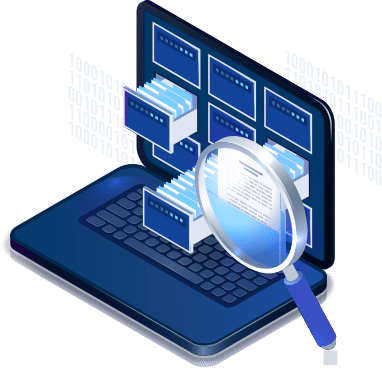Data Integrity During System Transitions: 5 Key Tactics for Finance Leaders
So you are planning to migrate data to new systems, what could possibly go wrong?
As it turns out, quite a lot.
From data corruption to complete loss, there are many challenges that come with major migration projects. The consequences of not overcoming these challenges are devastating. Avoiding these pitfalls starts with one fundamental principle: maintaining data integrity.
Data integrity refers to the accuracy, consistency, and reliability of data throughout its lifecycle. Ideally, data should remain unchanged, uncorrupted, and correctly recorded, regardless of where it is stored or how it is accessed, transferred, or processed.
In the context of system transitions or data migrations, maintaining data integrity means transferring it from one system to another without any loss, alteration, or corruption. The data should remain consistent across different systems or platforms.
Maintaining data integrity during system transitions helps financial services organizations avoid operational disruptions, regulatory penalties, and reputational damage. By implementing strategic tactics such as conducting comprehensive data audits, deploying parallel processing, and using advanced data matching tools, finance leaders can make sure that their data remains accurate, consistent, and secure throughout the migration process.
What Happens When You Fail to Maintain Data Integrity
In 2022, British bank TSB was fined $59.1 million for system disruptions and failing to maintain data integrity during a system migration. The fine was announced after a four-year investigation of a 2018 system migration that resulted in customers being unable to access digital banking services, and being able to see data that didn’t belong to them. Many customers also reported that they were presented with incorrect account information or missing transactions.
The incident was primarily caused by a failed IT migration when the bank attempted to move its customer data from its previous system, managed by Lloyds Banking Group, to a new system owned by its new parent company, Banco Sabadell.
The bank underestimated the scale and complexity of the migration. They also rushed the migration and did not have expertise when it came to Banco Sabadell’s Proteo4UK system (the new system they were transitioning to).
The transition resulted in major data inconsistencies. The bank did not have contingencies in place and could not roll back to the old system when data integrity was compromised.
Due to the disruptions and compromise in data integrity, the bank was charged with violation of the following regulations:
- Financial Conduct Authority (FCA) and Prudential Regulation Authority (PRA) Operational Resilience Regulations
- General Data Protection Regulation (GDPR)
- Payment Services Directive 2 (PSD2)
- FCA’s Treating Customers Fairly (TCF) Principle
- Service Level Agreements (SLAs) with Customers
Besides the $59 million fine, the bank also suffered from significant reputational damage and a loss of customers. All of the above was avoidable with the help of data governance best practices, thorough testing, and better data migration tactics.
Had TSB Bank implemented a structured approach to maintaining data integrity during the migration, they could have identified potential risks, rectified data inconsistencies, and gone through a smoother transition.
Challenges like the one faced by TSB are common in the financial services sector, especially when you have to undertake a major system transition or data migration project. At the end, it all comes down to planning, execution, and contingency plans to maintain data integrity.
Why Maintain Data Integrity During System Transitions
In the financial services sector, maintaining data integrity results in trust, compliance, and operational continuity.
Financial services companies upgrade systems and integrate their tech stack as new technologies hit the market. Upgrading, integration, and migration – all result in moving sensitive data from one database or system to another. And a lot can go wrong during this movement:
- Data Corruption: Incomplete or improper data transfer, especially when moving data between incompatible systems or formats.
- Data Loss: Errors during the migration process, such as failed transfers or overwriting of data without proper backups.
- Data Inconsistencies: Differences in data structures between old and new systems can lead to mismatches, where data does not align properly or is interpreted incorrectly.
- Security Vulnerabilities: During system upgrades or migrations, security protocols might be temporarily weakened, leaving data vulnerable to breaches or unauthorized access.
- Compliance Failures: Improper handling of data migration might lead to non-compliance with data protection regulations, such as GDPR, PCI DSS, or other industry-specific requirements.
If data integrity is compromised, it can lead to disruptions in operations, service outages, delays in processing transactions, or incorrect customer account information. Such disruptions damage the institution’s reputation and lead to a loss of customers (as it did in the case of TSB).
A lack of data integrity also results in low quality data for analysis. Financial services companies rely on data analysis to guide everything from investment strategies to customer relationship management. Any compromise in data integrity leads to flawed insights and suboptimal decisions.
Challenges with Data Integrity During System Transitions
As financial services companies upgrade systems, migrate data, or consolidate platforms, they face new challenges every step of the way.
- Data Fragmentation: Financial services organizations often operate with data spread across multiple systems, departments, and geographic locations with different formats, structures, and standards. When this data is consolidated into a new system, there are bound to be inconsistencies.
- Data Quality Issues: Legacy systems may contain outdated, duplicated, or incomplete records that, if migrated without proper cleansing, can corrupt the new system.
- Legacy System Constraints: Many financial institutions rely on outdated legacy systems that are not designed for modern data management practices. These systems may have limited capabilities for data extraction, transformation, and loading (ETL), making it difficult to migrate data accurately.
- Scalability Issues: Financial institutions usually have massive volumes of data. Large-scale migrations require scalable infrastructure and processes to handle the data load without compromising accuracy, which can be difficult to achieve without the right tools and expertise.
Reconciling all this data across legacy systems requires data profiling, standardization, cleansing, matching, and deduplication. Without these steps, you run the risk of data corruption, loss, or inaccuracies.
5 Tactics to Maintain Data Integrity
Now that we know all that can go wrong during a migration project, let’s look at some of the tactics you can use to maintain data integrity before, during, and after major migration or transition projects.
1. Conduct a Comprehensive Data Audit
Conducting a comprehensive data audit will provide you with a clear picture of the current state of data in your organization. Through the audit, you will identify areas for improvement, and lay the groundwork for a successful migration.
Here’s how you can conduct a data audit:
- Inventory All Data Sources: Catalog all data sources across the organization, including databases, applications, legacy systems, and external data feeds. Use Apache Atlas and Collibra Data Governance for this step.
- Assess Data Quality: Evaluate the quality of the data in each source by examining key attributes such as accuracy, completeness, consistency, and timeliness. Use Data Ladder for this step.
- Identify and Prioritize Critical Data: Identify which data sets are critical to the organization’s operations, compliance, and decision-making. Prioritize these data sets for thorough auditing. You can use Collibra Data Governance again for this step.
- Rectify Data Quality Issues: Improve data qualitythrough data cleansing, deduplication, standardization, and enrichment before the migration. Use Data Ladder again for this step.
- Document Findings and Prepare for Migration: Document the results of the data audit, including any issues found, corrective actions taken, and any data sets that require special handling during migration. You can do this via Google Workspace, SharePoint, or a similar collaboration and documentation platform here.
After corrective actions are taken, conduct a final validation to ensure that the data is now fit for migration. This step confirms that all data quality issues have been resolved and that the data meets the necessary standards for accuracy, consistency, and completeness. Use Data Ladder again for this step. The data profiling feature of Data Ladder will show you that the data is now of the required quality and ready for migration.
2. Implement Strong Data Governance Practices
Data governance helps you maintain high data quality and integrity in your organization. Establish clear policies, roles, and standards around data, enforce them, and minimize complex migration challenges when it comes to migration.
Here are some of the key components of data governance:
- Establish Clear Data Ownership and Accountability: Define roles and responsibilities for data management within the organization. Assign data stewards or data owners who are accountable for the accuracy, quality, and security of specific data sets.
- Develop and Enforce Data Management Policies: Create data management policies that cover all aspects of data handling like data creation, storage, access, and transfer. Align these policies with industry standards and regulatory requirements.
- Standardize Data Definitions and Formats: Implement standardized data definitions, formats, and naming conventions across the organization.
- Implement Data Quality Controls: Make regular audits, validation checks, and data cleansing processes a part of your governance framework.
- Ensure Compliance with Regulatory Requirements: Make a list of all regulatory compliances relevant to you and design your data governance practices to meet them.
Use Alation, Atlan, or a similar tool to create and implement data governance practices in your organization.
3. Use Advanced Data Matching and Deduplication Tools
Advanced data matching and deduplication tools help you keep your data accurate, consistent, and free from redundancies. These tools will help you monitor your data’s health and take corrective measures when data integrity is low.
Here’s how advanced data matching and deduplication tools work:
- Data Matching: Data matching tools use sophisticated algorithms to compare data across different sources and identify records that refer to the same entity, such as a customer, account, or transaction. These tools handle variations in data entry, such as misspellings, abbreviations, or different formats.
- Deduplication: Deduplication tools identify and remove duplicate records within a dataset. Duplicate data can arise from multiple entries of the same customer or transaction in different systems, or errors during data entry. By eliminating duplicates, you improve data quality and reduce storage costs.
- Data Enrichment: Some data enrichment tools augment your data with additional information from external sources, such as verifying customer addresses or appending missing details. This process makes the data more reliable for decision-making post-migration.
Financial institutions usually manage vast datasets, so make sure your data matching and deduplication tool is designed to handle large volumes of data efficiently. It should also have automation capabilities to minimize the need for manual intervention.
4. Conduct a Pilot Migration
A pilot migration involves transferring a small, representative subset of data to the new system before migrating the entire dataset. Doing this will allow you to test the migration process, identify potential issues, and make necessary adjustments before committing to a full-scale migration.
To conduct a successful pilot migration, follow these steps:
- Select a Representative Subset of Data: Choose a subset of data that accurately represents the full dataset in terms of complexity, volume, and diversity. This subset should include different data types, structures, and sources to ensure a comprehensive test.
- Plan and Document the Migration Process: Develop a detailed plan for the pilot migration, including specific objectives, timelines, and roles. Document the migration steps, including data extraction, transformation, and loading processes, as well as validation checks to be performed post-migration.
- Execute the Pilot Migration: Perform the pilot migration according to the plan. Monitor the process closely to identify any issues or deviations from expected outcomes.
- Conduct Post-Migration Validation: After the pilot migration, thoroughly validate the migrated data to make sure it meets the necessary standards for accuracy, consistency, and completeness. Perform data integrity checks, reconcile migrated data with the original dataset, and review system performance.
- Review and Adjust: Based on the outcomes of the pilot migration, review the entire process and identify any issues or areas for improvement. Adjust the migration plan, tools, or processes as needed to address these issues before proceeding with the full-scale migration.
Document the findings from the pilot migration, including any challenges encountered and solutions implemented. Use these insights to inform the planning and execution of the full migration.
5. Deploy Parallel Processing for Migration
In large-scale data migrations, especially within the financial services sector, the volume and complexity of data can be overwhelming. Parallel processing addresses these challenges by dividing the data migration workload into smaller, independent segments that can be processed simultaneously across multiple systems or processors.
Here’s how parallel processing works:
- Segmentation of Data: The first step in parallel processing is to segment the entire dataset into smaller, manageable chunks. These segments can be based on various criteria such as data type, source system, or organizational department.
- Simultaneous Processing: Each data segment is processed simultaneously across multiple processors or systems. This means that instead of migrating the entire dataset sequentially, different segments are migrated at the same time, significantly reducing the total time required for the migration.
- Load Balancing and Resource Optimization: Parallel processing also involves distributing the workload evenly across available resources. This means no single processor or system is overloaded and the migration process runs smoothly without bottlenecks or delays.
- Real-Time Monitoring and Error Handling: During parallel processing, real-time monitoring tools are used to track the progress of each segment. If errors or inconsistencies are detected in any segment, they can be addressed immediately without halting the entire migration process.
Besides scalability and efficient resource utilization, processing data in smaller segments reduces the risk of data corruption. If an issue occurs in one segment, it can be isolated and resolved without affecting the other segments, thus preserving the integrity of the rest of the data.
Data Ladder’s Role in Facilitating Secure Data Migrations
Data Ladder helps financial services organizations maintain data integrity before, during, and after data and system migrations. The company’s patented technology, Data Match Enterprise (DME), helps with:
- Comprehensive Data Profiling: Data Ladder analyzes data for accuracy, completeness, and consistency. It identifies duplicates, missing fields, and inconsistent formats and gives you a clear picture of your data quality at any given stage of the transition or migration process.
- Data Cleansing and Standardization: Data Ladder helps with detection and correction of data errors, such as misspellings, format inconsistencies, and duplicates.
- Advanced Data Matching and Deduplication: Data Ladder’s sophisticated matching algorithms utilize fuzzy logic to identify and reconcile related records across disparate data sets with high precision.
- Scalability and Flexibility: Data Ladder’s solutions are designed to handle large volumes of data, making them well-suited for the financial services sector, where datasets can be extensive and complex.
Whether you opt for a big bang migration or a phased approach, Data Ladder’s tools can be customized to meet the specific needs of your migration project.
Want to see Data Ladder in action? Download it for free and try it today. Or, learn more about what we can do for financial services organizations.










































